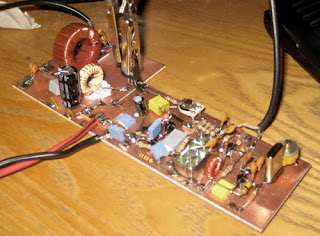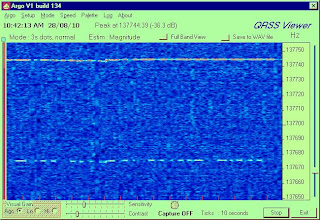 |
| See http://solarscience.msfc.nasa.gov/images/ssn_predict_l.gif |
31 Aug 2010
Solar activity progress
Labels:
solar storm,
sunspots
LF/MF antenna change
Today I changed the earth electrode antenna by raising the height of the connecting wires to form a (part) loop in the air as well as in the ground. The loop part in the air has an area of >100 sq metres. This should increase the effective loop area by a factor of at least 2, thereby improving the ERP. Later I'll repeat the tests with just the loop in the air only, so I have 3 different sets of results to compare. On 500kHz WSPR my signal with M0BMU (69km) was 6dB stronger than before with the earth electrode antenna. At the moment I am QRSS3 beaconing on 137.675kHz and seeking reports.
29 Aug 2010
136kHz WSPR - first report received
Well, it is no great DX at 3km away in the next village, but I've now received my first WSPR report on 136kHz from G6ALB. He gave me -21dB S/N when I was running 20uW ERP from the earth electrode antenna.
28 Aug 2010
WSPRing on 137.5kHz at last
 |
| 136kHz TX transverter |
 |
| My 20uW ERP QRSS3 signal as received by G3XIZ |
27 Aug 2010
136kHz TX transverter almost ready (5W from PA)
Today I should complete the first breadboard version of my QRP TX transverter for 136kHz. It mixes down from 10MHz in a similar arrangement to my 500kHz unit, which transverted down from 28MHz. ERP on the original 137.675kHz QRSS3 beacon has been increased by 3dB to 20uW. The ERP from the transverter into the earth electrode "antenna" will be about the same level initially. I'll run WSPR tests for the first time on 136kHz this weekend.
25 Aug 2010
Another report on the 136kHz QRPp beacon
G3XIZ has sent me a nice screenshot of my 10uW ERP 136kHz beacon as received in Biggleswade, about 35km away. Chris believes I'd be perfect copy with QRSS10 (10 second dots).
Labels:
136khz,
earth electrodes,
qrp
24 Aug 2010
62km with QRPp and earth electrodes on 137.675kHz
Today I ran an earth electrode transmission test with Mike G3XDV in Welwyn Garden City 62km away. I put my QRSS3 8-10uW ERP beacon on and Mike took regular screen shots through the day until mid afternoon. Although unable to copy the message in QRSS3, when using QRSS30 speed for reception the start and end of the message sequences (9 mins 7 seconds apart) could clearly be seen. He was able to precisely detect when the beacon was turned off. Mike estimates another 6-10dB should allow him to read the message properly. Signals were weaker later, possibly because of rain here altering the effective loop size within the ground.
Labels:
136khz,
earth electrodes,
g3xdv
22 Aug 2010
136kHz RX loop calibration
Today I attempted to calibrate my 136kHz 80cm loop antenna by measuring the signal strength of DCF39 in Germany on 138.83kHz. I'm told that the field strength of this signal in daytime in this area is around 1mV/m. The level of DCF39 was -4.5dB on the Spectran screen with the settings I used. So, by extrapolation 0dB on the screen should be close to 1.7mV/m.
I then measured the signal level of my QRSS3 beacon on 137.675kHz to see how much lower the level was at the same point about 1.5km away from the home QTH. My QRSS3 beacon was measuring -42dB approximately, corresponding to a field strength level of 12uV/m at 1.5km.
To work back to my ERP from the earth electrode antenna I used the formula ERP = (E * d)^2 /49 and this gives a result of 6.3uW and an antenna "loss" factor of 56dB (power in to RF out).
There are several sources of error:
I then measured the signal level of my QRSS3 beacon on 137.675kHz to see how much lower the level was at the same point about 1.5km away from the home QTH. My QRSS3 beacon was measuring -42dB approximately, corresponding to a field strength level of 12uV/m at 1.5km.
To work back to my ERP from the earth electrode antenna I used the formula ERP = (E * d)^2 /49 and this gives a result of 6.3uW and an antenna "loss" factor of 56dB (power in to RF out).
There are several sources of error:
- loop orientation +/-3dB
- loop Q/tuning +/-3dB
- measurement accuracy +/-2dB
17 Aug 2010
Chinese SSB and CW transceiver kits/built
YouKits of China is advertising a new 6 band HF SSB transceiver, the TJ6A that is available both in kit form and ready built. Prices look very attractive for a 10W transceiver. Well worth a look at their website. This last year we have begun to see Chinese ham products appearing. It is only a matter of time before a Chinese manufacturer will produce quality transceivers to seriously rival Icom and Yaesu, and at unbelievable prices.
Pakistan Floods
This map appeared on the Oxfam site today and gives a graphic indication of how much land is affected by the floods in Pakistan when overlaid on a map of the UK. It must be truly awful for the poor people there affected by this with crops, homes and businesses in ruin. Just imagine if this happened here (see map) and think how we would like the rest of the world's governments and peoples to help.
Help here: http://www.oxfam.org.uk/get_involved/campaign/actions/pakistan_response.html
Help here: http://www.oxfam.org.uk/get_involved/campaign/actions/pakistan_response.html
Labels:
oxfam,
pakistan floods
Subscribe to:
Posts (Atom)






